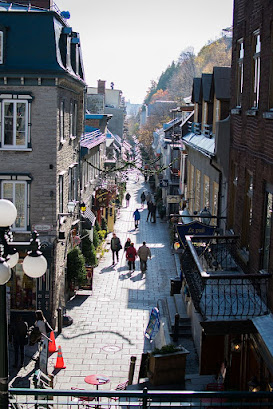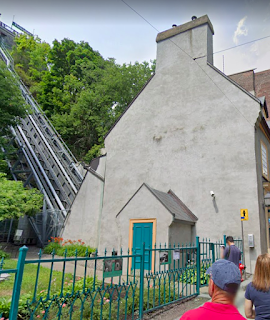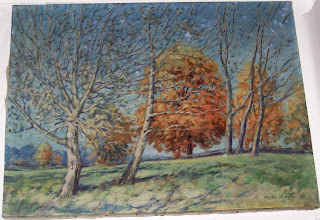A painting we've known well for many decades has recently attracted our more studied attention.
We’ve always been aware of the locale it depicts. It was painted in a picturesque valley in East York, a little east of Dawes Rd, part of the area now called Taylor Creek Park. In 1897, Walter Massey (President of the Massey Harris Company) purchased 240 acres of farmland in that valley, calling it Dentonia Park in honour of his wife, Susan Marie Denton. They developed the existing farm into a prosperous and forward-looking dairy farm (supplying Walter’s Toronto City Dairy Company) that also produced eggs, poultry, and trout.
Three impressive homes were built in the parklands at various times (one still stands, near the north edge of the Park, a tudor-style house now used by the Children’s Peace Theatre). Several members of the extended Massey family lived in Dentonia Park in the ensuing years. Sadly and ironically, Walter Massey died in 1901 of typhoid fever at the age of 37, but Susan carried on the farm’s operation and its dedication to providing safe pasteurized milk to a large part of Toronto’s population.
In about 1926, in memory of her husband, Susan donated 60 acres of the land to the City of Toronto for use as a public park, requiring the name Dentonia Park to be preserved (it’s now the City-owned Dentonia Park Golf Course). Then, in 1933, she donated another 40 acres, including two fine large houses, to Crescent School, an independent school for boys. The greater of those two houses became the School’s main building; the lesser, called Denton House, provided accommodation for members of staff and their families.
Our father’s first employment after he returned from overseas service in WWII was as a teacher at Crescent School. Thus Denton House became our family’s home from 1945 till the summer of 1950. It was almost certainly during that period that our Auntie Bert painted the painting shown above. It looks eastward across a pond toward a steep slope in the background, beyond the top of which would have been the Crescent School main building.
Now we come to the puzzle. The painting shows a white-ish structure at the top of the slope that is rather curious, apparently with three tall, narrow, open arches, each one rounded at the top (the shape of the openings is especially clear in one of three rougher sketches we have of the same composition). There may be a roof or turret visible at the left-most end of the structure. But what could that structure be?
I recently set out to search for photographs of the Massey house and Crescent School, but the search turned up very little. There was a Toronto Star article in 1933, reporting Susan Denton Massey’s donation to Crescent School, that had an excellent photo of what turns out to be the east-facing front of the big house, but there is not much else to be found.
There’s a chimney on the left of the photo whose top part bears a slight resemblance to the mysterious structure in the painting. At first it seemed to me to be out of scale (too large) to be a chimney, and I even wondered if it was a bell tower, but I’ve since seen another photo from almost the same angle showing clearly that it was a brick chimney, and that at one time the top part was not present (I don’t know which photo was earlier, though).
Enlarging the photo, it’s evident that someone (perhaps the Toronto Star photo editor?) has rather clumsily used some sort of pen or marker to emphasize the outlines of the structure, and even the lines of the roof below it. Very odd.
We’ve had a family debate about whether the top of this chimney could have been visible, peeking up above the brow of the slope, from the distant spot below where Bertha was painting. I don’t believe it could have been. A study of the two photos’ angles of view (aided by an aerial photo that is discussed below) shows that the chimney had to be quite close to the front (the east end) of the house. It was therefore almost certainly not tall enough to be visible from a viewpoint far to the west and below the slope. And even if it had been, it is not nearly large enough to be the structure depicted in the painting, and the openings in the top part are the wrong shape.
What other structures might there have been? Large scale Fire Insurance Plans from the early part of the twentieth century can be enormously helpful in answering such questions, but when I searched, I found that their coverage does not extend into Dentonia Park itself (among those I can access online, anyway). If no Plans were made, I speculate that it might be because there weren’t enough buildings on the large site to justify the surveying work.
I did, however, come across a few rather grainy and indistinct aerial photos of Dentonia Park. This one from 1947 shows the two houses, and it can be seen that the larger house, the Crescent School main building (whose east-facing front entrance is shown in the photo above), extended a long way westward, almost to the top of the slope. There appear to be some odd-shaped features at that west end. Is it one of those that could be seen from across the pond?
A good friend of our family is related to the Masseys on his mother’s side. He was a visitor to Dentonia Park during his boyhood years, in the years after our family had moved away. We have showed him the painting and asked him if he could remember such a building, but he has no recollection of it.
Is it possible it didn’t ever exist? There is an old tradition in grand English country estates of placing classical-looking structures in carefully selected locations where they will provide points of artistic focus in the pastoral vistas, so carefully designed to look completely natural. They are usually referred to as follies. It occurs to me to wonder, sometimes, whether Bertha put a structure into her painting that wasn’t actually there, but which she thought might have been placed there if the Masseys had wanted a folly. Or, perhaps the top of the chimney was visible, and she used it as the basis for an enlarged but imaginary folly.
This week I decided to email the Crescent School office staff (still at the campus on Bayview Avenue to which the School moved in 1969). Marketing and Communications Specialist Leigh Bowser replied promptly, writing that they don’t know of any relevant archival photos, but pointing me to a video on youtube, a 2005 DVD celebrating the history of the School, 1913 – 2004, in old photos and film footage. Click
HERE.
There’s nothing conclusive in the video – but in the oldest footage from Dentonia Park there is part of an unidentified building with at least one arched opening of the right sort of shape and size. Tantalizing!
My great hope is that someone who reads this posting will recognize the view from the pond’s edge, and help us solve the mystery!

 Bertha also left us several bound sketchbooks, including one which has many references to Québec and must have been her constant companion during her time there. The second page has a rough pencil sketch of a horse and cart which appears to have been a preliminary study for the oil painting – same position, same angle.
Bertha also left us several bound sketchbooks, including one which has many references to Québec and must have been her constant companion during her time there. The second page has a rough pencil sketch of a horse and cart which appears to have been a preliminary study for the oil painting – same position, same angle.

 Taken all together, these clues strongly suggest that the oil painting, along with Bertha’s smaller watercolour version of the same scene, are indeed depictions of the rue du Petit-Champlain.
Taken all together, these clues strongly suggest that the oil painting, along with Bertha’s smaller watercolour version of the same scene, are indeed depictions of the rue du Petit-Champlain.





























